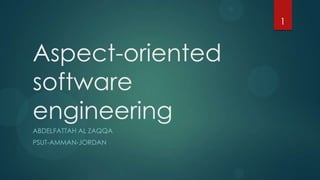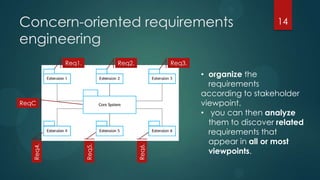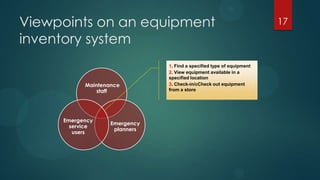Aspect oriented software engineering-draft
- 2. Topics covered ’üĄ The separation of concerns ’üĄ Aspects, join points and pointcuts ’üĄ Software engineering with aspects 2
- 4. Complex Change on Requirements ’üĄ 4 Needs Even in reuse components (remove extra code) understanding and changing several components
- 6. End intro 6
- 7. Aspects, join points, and pointcuts ’üĄ 7 Example: Assume that we have medical records system such as MHCPMS. handle MHCPMS components Holds Prescribed medication Patient info. Holds Personal Info. updatePersonalInformation (patientId, infoupdate) updateMedication (patientId, medicationupdate) by authorized person only
- 8. solutions ’üĄ Problem: Somehow illegal update happen ’üĄ Solutions: 1. re-authentication before any change’āĀ tangled implementation’āĀ authentication with logging or not, where?!. 2. Modify system to do authentication each time update method called ’āĀ scattered implementation.’āĀ every call?! Several different place? * Cross cutting between authentication and logging 8
- 9. An authentication aspect in Aspect 9 Where it will be Oriented system woven into aspect authentication program { before: call (public void update* (..)) // this is a pointcut { // this is the advice that should be executed when woven into // the executing system int tries = 0 ; string userPassword = Password.Get ( tries ) ; Advice while (tries < 3 && userPassword != thisUser.password ( ) ) { // allow 3 tries to get the password right tries = tries + 1 ; userPassword = Password.Get ( tries ) ; } if (userPassword != thisUser.password ( )) then //if password wrong, assume user has forgotten to logout System.Logout (thisUser.uid) ; } } // authentication
- 10. Terminology used in aspectoriented software engineering Term Definition advice The code implementing a concern. aspect A program abstraction that defines a cross-cutting concern. It includes the definition of a pointcut and the advice associated with that concern. An event in an executing program where the advice associated with an aspect may be executed. The set of events that may be referenced in a pointcut. join point Not standard join point model pointcut weaving A statement, included in an aspect, that defines the join points where the associated aspect advice should be executed. The incorporation of advice code at the specified join points by an aspect weaver. 10
- 11. aspect authentication { before: call (public void update* (..)) // this is a pointcut Monitor: Execution (System.Logout (thisUser.uid) ) {public void get(System.systime) } { int tries = 0 ; string userPassword = Password.Get ( tries ) ; while (tries < 3 && userPassword != thisUser.password ( ) ) { // allow 3 tries to get the password right tries = tries + 1 ; userPassword = Password.Get ( tries ) ; } if (userPassword != thisUser.password ( )) then //if password wrong, assume user has forgotten to logout System.Logout (thisUser.uid) ; } after: call (public void update* (..)) { public void logging(userID.Get(uid) } } // authentication 11
- 12. 12 Source code preprocessing Rarely used Link time weaving, modify compiler Most common Dynamic weaving at execution time More flexible
- 13. End Aspects, join points, and pointcuts 13
- 14. Concern-oriented requirements engineering Req1. Req2. Req3. Req6. Req5. ReqC Req4. 14 ŌĆó organize the requirements according to stakeholder viewpoint. ŌĆó you can then analyze them to discover related requirements that appear in all or most viewpoints.
- 15. Viewpoints and Concerns Cross-cutting concerns are concerns that are identified by all viewpoints. 15
- 16. Viewpoints on an equipment inventory system 1. Emergency service users 1.1 Find a specified type of equipment (e.g., heavy lifting gear) 1.2 View equipment available in a specified store 1.3 Check-out equipment 1.4 Check-in equipment 1.5 Arrange equipment to be transported to emergency 1.6 Submit damage report 1.7 Find store close to emergency 2. Emergency planners 2.1 Find a specified type of equipment 2.2 View equipment available in a specified location 2.3 Check-in/cCheck out equipment from a store 2.4 Move equipment from one store to another 2.6 Order new equipment 16 3. Maintenance staff 3.1 Check -in/cCheck -out equipment for maintenance 3.2 View equipment available at each store 3.3 Find a specified type of equipment 3.4 View maintenance schedule for an equipment item 3.5 Complete maintenance record for an equipment item 3.6 Show all items in a store requiring maintenance
- 17. Viewpoints on an equipment inventory system Maintenance staff Emergency service users Emergency planners 1. Find a specified type of equipment 2. View equipment available in a specified location 3. Check-in/cCheck out equipment from a store 17
- 18. Availability-related requirements for the equipment inventory system AV.1 There shall be a ŌĆśhot standbyŌĆÖ system available in a location that is geographically well-separated from the principal system. Rationale: The emergency may affect the principal location of the system. AV.1.1 The system shall send status information to the emergency control room system every five minutes. Rationale: The operators of the control room system can switch to the hot standby if the principal system is unavailable. 18
- 19. Inventory system - core requirements ’üĄ C.1 The system shall allow authorised users to view the description of any item of equipment in the emergency services inventory. ’üĄ C.2 The system shall include a search facility to allow authorised users to search either individual inventories or the complete inventory for a specific item or type of equipment. 19
- 20. Inventory system - extension requirements ’üĄ E1.1 It shall be possible for authorised users to place orders with accredited suppliers for replacement items of equipment. ’üĄ E1.1.1 When an item of equipment is ordered, it should be allocated to a specific inventory and flagged in that inventory as ŌĆśon orderŌĆÖ. 20
- 21. General rule ’üĄ many concerns or extensions to the system confuse the reader and may lead to premature design. ’üĄ limits the freedom of designers and may result in a system design that cannot meet its quality of service requirements. 21






















